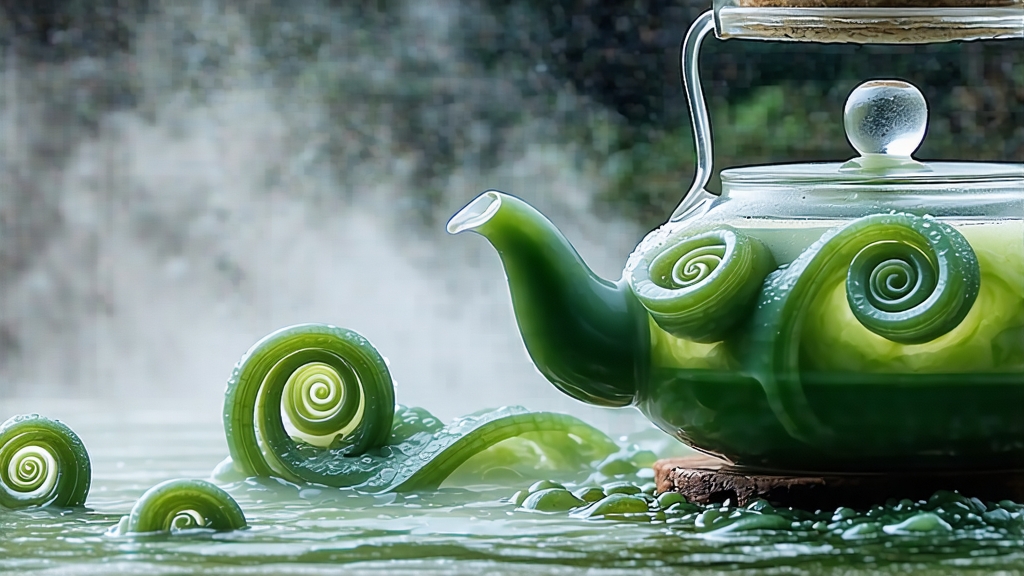
Biluochun, whose name translates literally to “Green Snail Spring,” is one of China’s ten most celebrated teas, yet among green teas it remains the most delicately fragrant and visually distinctive. International drinkers often meet it under the alternate name Pi Lo Chun, a phonetic carry-over from earlier romanization systems, but whatever the spelling the tea is instantly recognizable: tiny, spiral-shaped pellets of jade-green down that resemble miniature snail shells. One gram contains more than one hundred individual buds, each rolled so tightly that when dropped into water they look like minuscule fireworks unfurling in slow motion. The spectacle is only the prelude; the cup delivers an aroma so intense that the Qing-dynasty Emperor Kangxi is said to have changed the tea’s original name “Xia Sha Ren Xiang” (“Scary Fragrance”) to the more elegant Biluochun after being captivated by its perfume during his southern inspection tour of 1699.
History and Terroir
The tea is indigenous to the Dongting mountain range that rises from the northern shore of Lake Tai in Jiangsu Province, a region long praised in classical poetry for its misty micro-climate and fruit orchards. Two specific peaks—Dongshan (East Mountain) and Xishan (West Mountain)—produce the only authentic “Lake Tai Biluochun.” The mountains are actually peninsular fingers jutting into the lake, so morning mist lingers longer, diffusing sunlight and forcing the tea bushes to synthesize more amino acids and aromatic volatiles. Local fruit trees—peach, plum, apricot, and loquat—are interplanted with tea because farmers discovered centuries ago that the shared pollinator activity and overlapping root systems subtly influence leaf chemistry, yielding the tea’s signature fruity-floral bouquet. In pre-modern times the entire crop was reserved for imperial tribute; even today the spring harvest is still partially allocated to state banquets, so very little leaves China, making high-grade Biluochun a rare sight on Western shelves.
Cultivar Hierarchy
Chinese merchants classify Biluochun into seven unofficial grades, but connoisseurs focus on three:
- Supreme Seven-Down (Qí-xīng): picked on the first three days of the lunar spring, consisting solely of single buds still covered in seven layers of microscopic hairs.
- Superior One-Bud-One-Leaf (Chāo-qíng): the bud and the adjacent half-unfurled leaf, plucked before the Qingming festival.
- Standard Fine (Tè-jí): slightly larger, picked before the Grain Rain.
Anything harvested later is considered “bulk” and exported as generic Jiangsu green tea. The supreme grade is so labor-intensive—roughly 90,000 buds yield only 500 g of finished tea—that its retail price routinely exceeds that of top-tier Longjing.
Plucking Discipline
Authentic production begins at dawn when mountain dew is still visible. Pickers, usually women wearing bamboo hats, snap off the tender shoot with a fingernail click that avoids bruising the stem. Leaves are dropped into small wicker baskets lined with fresh orchard petals to prevent oxidation and to absorb additional floral notes. The basket never exceeds 1 kg capacity; compression would generate heat and “burn” the edges. Within two hours the harvest must reach the village workshop, because even a short delay initiates enzymatic browning that dulls the brilliant jade color.
Crafting the Spiral: A Six-Step Choreography
- Withering: The buds are spread on bamboo trays set under shade cloth for 30–40 minutes, just long enough for surface moisture to evaporate while internal water content remains above 72 %.
- Fixation (Kill-Green): A wok heated to 180 °C receives 250 g of leaf. The master’s palm—protected only by years of calloused experience—stirs the mass in a figure-eight for 3–4 minutes, deactivating polyphenol oxidase and locking in the green hue.
- Primary Rolling: Temperature drops to 70 °C. Using alternating palm pressure and finger flicking, the maker begins to bend the bud around its axis. This is where the future spiral is seeded; too much force snaps the sprout, too little fails to break cell walls for later aroma release.
- Re-Firing and Shaping: The leaf is removed, allowed to cool for five minutes, then returned to a 60 °C wok for the critical